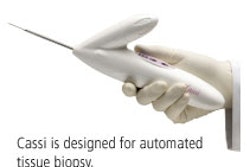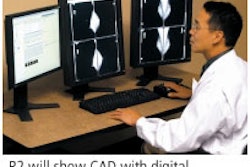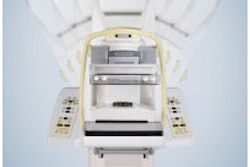The use of computer-aided detection (CAD) systems can help detect breast cancer much sooner, according to a study team led by researchers from George Washington University (GWU) Medical Center in Washington, DC.
"CAD can detect breast cancer earlier, whether it is masses or calcifications, and in our study, a mean of 15 months earlier," said Dr. Rachel Brem. "And CAD can detect even the smaller of breast cancers."
Brem presented the study team's results at the 2005 RSNA meeting in Chicago.
The researchers sought to evaluate the performance of CAD in detecting breast cancers missed at screening mammography based on mammographic appearance and lesion size, as well as assess the benefit of CAD in the early detection of breast cancer. Eighteen centers contributed 906 screen-detected breast cancer cases and 147 normal cases.
Screening mammograms from nine to 24 months prior to cancer diagnosis were available in 374 cases and reviewed blindly by three radiologists from a panel of six expert mammographers, according to Brem. The review was performed to determine if in fact there were abnormal areas warranting workup, which was recommended in 314 cases, she said.
In 174 of 314 cases, one or more radiologists identified an abnormality with the appearance and location of the subsequently confirmed cancer, Brem said. The mammographic lesions type and size were assessed for all 174 missed cancer cases; architectural distortions and focal asymmetric masses were classified as masses.
The researchers then utilized CAD software (Second Look, version 7.0, high operating point, iCAD, Nashua, NH) for retrospective evaluation of the 174 prior cases, as well as the 147 normal mammograms, in order to assess CAD's sensitivity in detecting missed cancers and the technology's false-positive rate.
The CAD software correctly marked 72% of the 174 missed cancer cases with a false-positive rate of 2.8 marks per four-film case, according to the researchers. There were 59 total missed microcalcifications from the screening mammograms, including 19 less than 6 mm, 16 6-10 mm, 13 11-20 mm, and 11 greater than 20 mm. CAD yielded overall sensitivity of 83% for all of the microcalcifications, with sensitivities by size of 79% for less than 6 mm, 63% for 6-10 mm, 100% for 11-20 mm, and 100% for microcalcifications greater than 20 mm, Brem said.
Overall, there were 115 missed masses from the screening mammograms, including seven less than 6 mm, 57 6-10 mm, 42 11-20 mm, and nine greater than 20 mm. CAD produced overall sensitivity for the missed masses of 67%, with sensitivities by size of 57% for masses less than 6 mm, 61% for 6-10 mm, 71% for 11-20 mm, and 89% for masses greater than 20 mm.
"Our study demonstrates that 72% of missed breast cancers were detected by CAD nine to 24 months prior to cancer diagnosis," Brem said.
The researchers did not find a statistical difference in sensitivity based on lesion size for masses (p = 0.12), but there was a statistical difference in performance based on missed microcalcifications (p = 0.004). The mean size of missed cancers manifesting as microcalcifications was 15 mm (range 3-90 mm) and for masses was 12 mm (range 4-36 mm), she said.
"The earlier detection of breast cancer by CAD has the potential to improve mortality from breast cancer," Brem said.
By Erik L. Ridley
AuntMinnie.com staff writer
January 30, 2006
Related Reading
CAD results as evidence in Ohio trial may open the door to future rulings, January 4, 2006
Breast MRI CAD yields specificity gains, December 12, 2005
CAD falls short of double reading for breast cancer detection, October 25, 2005
Sharp rise in U.K. breast cancer survival rates, October 10, 2005
Breast cancer drug move gives hope to U.K. patients, October 6, 2005
Copyright © 2006 AuntMinnie.com



















